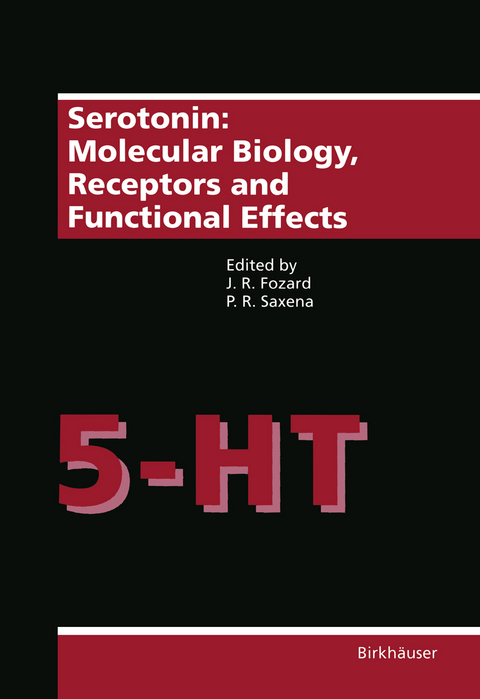
Serotonin: Molecular Biology, Receptors and Functional Effects
Springer Basel (Verlag)
978-3-0348-7261-4 (ISBN)
I: Molecular Pharmacology, Cell Biology, Binding Sites and Receptors.- A tribute to Dr. Irvine H. Page.- Molecular neuroanatomy of 5-HT receptors.- Cloning and expression of a human 5-HT1D receptor.- Developmental and synaptic regulation of 5-HT2 and 5-HT1C serotonin receptors.- Serotonin trophic factors in development, plasticity and aging.- A neurotrophic factor - SNTF - for serotonergic neurons.- Molecular mechanisms of action induced by 5-HT3 receptors in a neuronal cell line and by 5-HT2 receptors in a glial cell line.- Characterization of 5-HT3 receptor mediated electrical responses in nodose ganglion neurones and clonal neuroblastoma cells maintained in culture.- Specific antibodies as new tools for studies of central 5-HT1A receptors.- 5-HT1C 5-HT1D and 5-HT2 receptors in mammalian brain: Multiple affinity states with a different regional distribution.- Second messengers in the definition of 5-HT receptors.- 5-HT1P receptors in the bowel: G protein coupling, localization and function.- Is contraction to serotonin mediated via 5-HT1C receptor activation in rat stomach fundus?.- Further definition of the 5-HT receptor mediating contraction of rat stomach fundus: relation to 5-HT1D recognition sites.- Temperature dependence of agonist and antagonist affinity constants at 5-HT1 -like and 5-HT2 receptors.- Characterization of 5-HT3-like receptors in the rat cortex: Electrophysiological and biochemical studies.- Binding characteristics of a quarternary amine analog of serotonin: 5-HTQ.- 5-HT1-like receptors unrelated to the known binding sites?.- II: Peripheral and Central Pharmacology.- The electrophysiology of 5-HT.- Pharmacological characterization of brain 5-HT4 receptors: Relationship between the effects of indole, benzamide and azabicycloalkylbenzimidazolonederivatives.- Pharmacological properties of the putative 5-HT4 receptor in guinea-pig ileum and rat oesophagus: Role in peristalsis.- 5-HT1D and 5-HT4 receptor agonists stimulate the peristaltic reflex in the isolated guinea pig ileum.- The 5-HT4 receptor mediating tachycardia in the pig.- Contractile 5-HT1D receptors in human brain vessels.- Human, monkey and dog coronary artery responses to serotonin and 5-carboxamidotryptamine.- 5-Carboxamidotryptamine induced renal vasoconstriction in the dog.- The subretrofacial nucleus: A major site of action for the cardiovascular effects of 5-HT1A and 5-HT2 agonist drugs.- Cardiovascular effects of injection of 5-HT, 8-OH-DPAT and flesinoxan into the hypothalamus of the rat.- Pharmacological characterization of the receptor mediating 5-HT evoked motoneuronal depolarization in vitro.- Stimulation of 5-HT3 receptors inhibits release of endogenous noradrenaline from hypothalamus.- Antagonism of serotonin agonist-elicited increases in serum corticosterone concentration in rats.- Influence of 5-HT1A and 5-HT2 receptor agonists on blood glucose and insulin levels.- Novel in vivo models of 5-HT1A receptor-mediated activity: 8-OH-DPAT-induced spontaneous tail-flicks and inhibition of morphine-evoked antinociception.- Evidence that the unilateral activation of 5-HT1D receptors in the substantia nigra of the guinea-pig elicits contralateral rotation.- III: Pathophysiological Roles and Prospects for New Therapies.- 5-Hydroxytryptamine and the human heart.- The effects of BRL 24924 (renzapride) on secretion of gastric acid and pepsin in dogs.- Constipation evoked by 5-HT3 receptor antagonists.- Subchronic D-fenfluramine treatment enhances the immunological competence of old female Fischer 344 rats.- Serotonin as a vascular smooth muscle cell mitogen.- Serotonin, the endothelium and the coronary circulation.- Effects of selective 5-HT, receptor antagonists on some haemodynamic changes produced by experimental pulmonary embolism in rabbits.- The vasoconstrictor action of sumatriptan on human isolated dura mater.- Influence of 5-HT3 receptor antagonists on limbic-cortical circuitry.- Utilization of zacopride and its R- and S-enantiomers in studies of 5-HT3 receptor "subtypes".- CP-93,129: A potent and selective agonist for the serotonin (5-HT1B) receptor and rotationally restricted analog of RU-24,969.- Differentiation of 8-OH-DPAT and ipsapirone in rat models of 5-HT1A receptor function.- Initial studies in man to characterise MDL 73,000EF, a novel 5-HT1A receptor ligand and putative anxiolytic.- 8-OH-DPAT-induced hypothermia in rodents. A specific model of 5-HT1A autoreceptor function?.- Serotonin release is responsible for the locomotor hyperactivity in rats induced by derivatives of amphetamine related to MDMA.
| Erscheint lt. Verlag | 25.2.2012 |
|---|---|
| Zusatzinfo | XII, 512 p. |
| Verlagsort | Basel |
| Sprache | englisch |
| Maße | 170 x 244 mm |
| Gewicht | 900 g |
| Themenwelt | Medizin / Pharmazie ► Medizinische Fachgebiete ► Pharmakologie / Pharmakotherapie |
| Naturwissenschaften ► Biologie ► Biochemie | |
| Sozialwissenschaften | |
| Schlagworte | Biology • Drug • Molecular Biology • pharmacology • Research • Serotonin |
| ISBN-10 | 3-0348-7261-5 / 3034872615 |
| ISBN-13 | 978-3-0348-7261-4 / 9783034872614 |
| Zustand | Neuware |
| Informationen gemäß Produktsicherheitsverordnung (GPSR) | |
| Haben Sie eine Frage zum Produkt? |
aus dem Bereich


